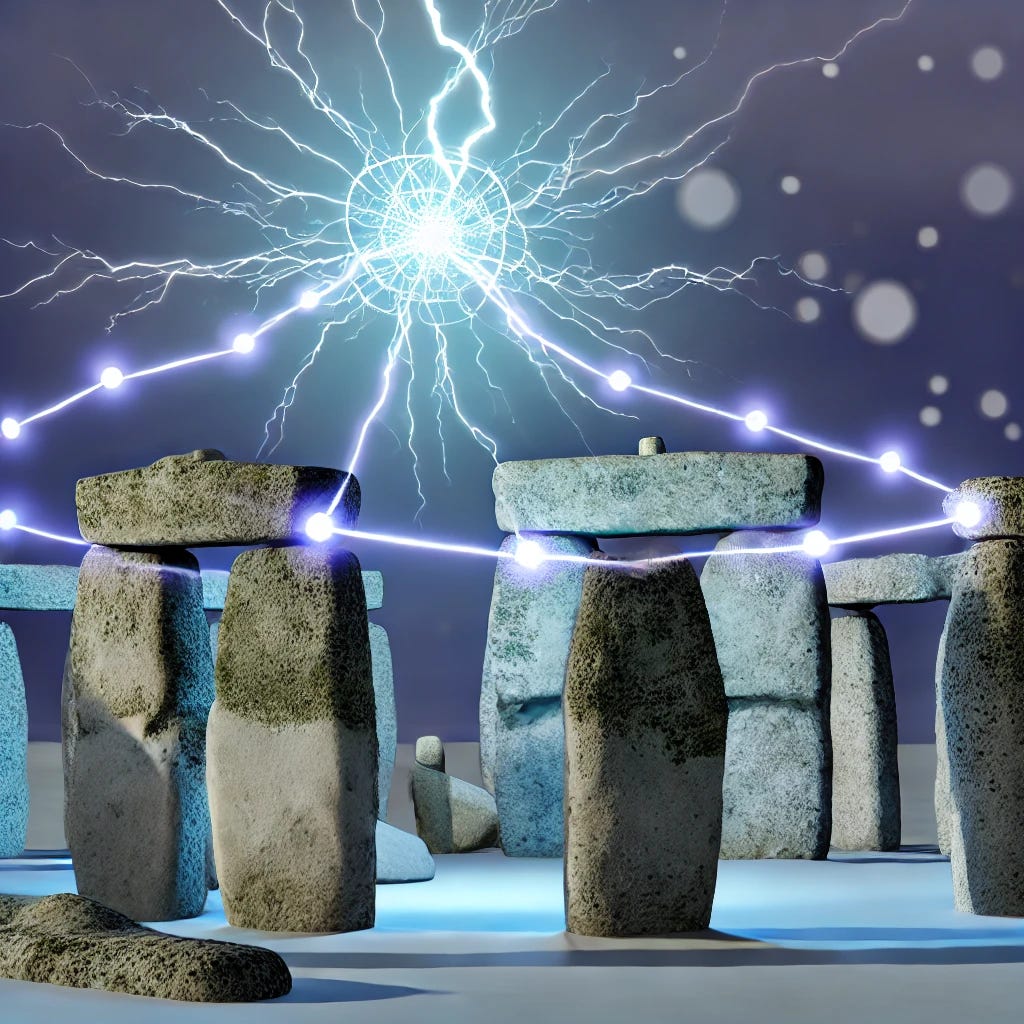Stonehenge and Ancient Technology
Have We Reverse Engineered A Free Energy Megalithic Network?
Copyright © John R. Clarke 2024
photo John R Clarke@Substack
The story of the haunted house is one that is particularly enduring, both a classic and constantly finding itself reinvented. It is a story often told from the perspective of a replacement bride, like in the novel and film Rebecca, or a family, like in Poltergeist or Amityville.
A house is moved in to, in a spirit of joy and anticipation. Very soon, however, the bride or family start to discover that there is something wrong with the house. It has a troubled history, something happened to the people that lived here before. Something awful.
This idea has a real appeal to us and resonates with us on a personal level in the microcosm. It also applies to us in the macrocosm. We are all, regardless of nationality, inhabitants of one house, that of Earth. It is the house of the human race in a very real way. It’s always been our house; we have always lived here.
Yet - there are gaps in the narrative of our history that should not be there. It is undeniable that someone lived here before. We have come across the things they left behind, incredible monuments and megaliths that we know do not belong to us, that could not have been created during our time here.
We find ourselves asking the same questions that are asked in any haunted house story- who lived here before? What were they like? What happened to them? Could it happen to us? We intuitively feel, also in the way of such stories, that our destiny is somehow tied up with theirs, that if we can discover what happened to them, it might hold the answer to our own purpose – our own fate.
This unease, this not entirely unpleasant sense of an incomplete story, is particularly potent around ancient stone sites. Our more recent ancestors felt it too, responding in ways that reveal their own fears and fascinations. Puritans, convinced these stones harboured devil-worship, attempted to destroy them through destructive means - heating them with fire, then dousing them with cold water to make them shatter. Others simply buried them, as if hiding away something they couldn't quite understand1.
photo John R. Clarke@Substack
While not every village has structures as grand as Stonehenge or Avebury, many still have their own single sarsen stone, silent, forgotten guardians, having become unlikely places of compassion where food was left for those afflicted with leprosy and other diseases that forced them to live apart from society. Many larger standing stones were incorporated into church foundations or doorways to Christianize what came before2.
These ancient stones have always been associated with strange phenomena. Visitors report inexplicable sounds - rolling thunder on clear days, distant voices in empty fields, mysterious lights in the darkness. Some describe an odd buzzing or humming emanating from the stones themselves. Others have reported receiving electrical shocks from touching the stones. Today, larger sites like Stonehenge draw thousands to their dawn ceremonies during equinoxes, suggesting a deep recognition of their power that transcends our modern scepticism.
Yet for all our investigations and theories, the true purpose of these sites has remained elusive. We assume our ancestors could have built them for nothing more sophisticated than marking the seasons or honouring the dead. But what if these silent stones have more in common with our modern technology than we've ever imagined?
The monumental structures left behind by our ancestors present an uncomfortable puzzle: the sophistication of these sites suggests a civilization capable of generating and controlling remarkable amounts of energy - an ability that shouldn't exist according to our linear view of human progress.
How do we reconcile these ancient achievements with our assumptions about technological development? The engineering precision of Stonehenge, the careful selection and transportation of specific stones across vast distances, the exact astronomical alignments - all point to capabilities that seem impossible without significant technological advancement and sophisticated methods of utilising energy.
What if proof of scientific advancement has been in plain sight all along and only now, as science advances, can we begin to recognize it? Perhaps our science is only now reaching a point where it can reflect back on the ancient past, raising new questions rather than providing conclusive answers.
The Megalithic Network Theory: Earth’s Integrated Smart House System
Perception can be like one of those lenses that the optician places in front of your eyes and then, turning it the other way, asks, is it clearer like this? Or like this?
There is the enduring perception that we represent the pinnacle of technology and that anything that went before us did not have access to technology as we understand it. For whatever reasons, this idea of linear progression has become extremely entrenched despite increasing evidence to the contrary.
To understand this theory, we are going to use one of alchemy’s most cherished perceptive tools, that of inversion. We are going to keep the lens of science, we are merely going to invert or flip the perception that we are the pinnacle of technology. Instead, we are going to view this mysterious ancient civilisation as truly scientifically advanced - something we are moving towards and not away from. With that minor adjustment in place, we are ready to see Stonehenge through the eyes of modern alchemists. We will ask the stones themselves what an advanced scientific civilisation might have intended for their function, where the sarsens and bluestones together form a sophisticated energy network—using natural resources in ways that echo through ancient mythology yet undeniably align with the concepts of modern energy transmission through our familiar daily devices and smart houses.
The Power of Quartz: Sarsens as Energy Amplifiers
Sarsens are composed largely of quartz—a form of crystalline silica known for its unique and powerful properties. In modern technology, quartz is valued for its piezoelectric and conductive characteristics. When pressure is applied, quartz crystals can generate an electric charge, a property that has applications in everything from watches to advanced electronics. This piezoelectric effect3 means that sarsens, under certain conditions, could act as natural energy transducers, turning physical force or vibrational energy into an electric potential. When applied to Stonehenge, the sarsens’ quartz content suggests an ancient understanding of energy that parallels our modern use. This raises the possibility that these builders may have aligned scientific properties with a spiritual purpose, bridging energy manipulation with mythic traditions of power and life force embedded in stone.
Quartz’s crystalline structure makes it a highly stable conductor of sound and energy, allowing for amplification and even storage of energy. This stability and its ability to oscillate precisely make it invaluable in radio technology, where quartz is used to control frequencies.
If we apply these principles to Stonehenge, it’s intriguing to consider that the sarsens could act as capacitors or amplifiers, hypothetically storing vibrational or electric energy and intensifying signals from the environment.
The Properties of Bluestones
If the sarsens at Stonehenge function as capacitors or amplifiers, then the bluestones—those smaller, distinct stones transported from the Preseli Hills in Wales—could serve a complementary, equally critical role. Unlike the quartz-dense sarsens, the bluestones contain high levels of various metals and minerals, making them naturally more conductive. Their composition includes elements such as copper and iron oxides, which are known to enhance conductivity and could facilitate the transfer of energy across the stone circle. Those scarcer, blue crystals provided necessary ‘doped’ material traits not sufficiently present in native sarsens to properly activate the sought subtle energy dynamics at megalithic scale. The combination of these different materials creates something even more sophisticated at the quantum level. Each type of stone has what physicists call a different band gap - essentially the amount of energy needed for electrons to jump from one energy state to another, specific energy thresholds that electrons must cross to move between states. This is a fundamental property of how energy is absorbed and released. When materials with different band gaps are brought together, as with the sarsens and bluestones, they can create a system capable of processing a wider range of energy frequencies. By matching the molecular structure of different stone groupings, the builders may have created an array that could capture and transmit a broader spectrum of electromagnetic energy than either type of stone could achieve alone. This might explain not just why these specific stones were chosen, but why their precise arrangement was so crucial - they needed to be positioned in ways that would allow their band gaps to harmonize and create optimal energy flow through the system.
photo John R. Clarke@Substack
Quantum-Level Interactions
This interplay of materials extends beyond their basic electrical properties. At the molecular level, the bluestones exhibit another crucial property. Their heterogeneous mineral composition creates unique molecular bonds that can oscillate at various frequencies. When activated - whether by sound, electromagnetic fields, or cosmic radiation - these molecular oscillations act as natural frequency modulators. Just as metronomes will gradually align their rhythms through shared vibrations, these molecular oscillations could create harmonized frequencies across the stone structure. They are the drummers in this energy symphony, controlling the tempo and setting the pace.
These molecular interactions extend into quantum-level effects. In quantum physics, what we perceive as empty space is actually filled with fleeting particles and energy fields - what physicists call vacuum fluctuations, or the small, fleeting energy fields that exist even in empty space. A bit like the underlying vibration of reality itself, the deepest bass note in existence, usually too subtle to hear. The specific crystalline structures and geometric arrangements of the stones could interact with these quantum fluctuations, especially when the stones molecular oscillations are activated, a bit like an amplifier picking up and magnifying this cosmic background rhythm. When materials are arranged in certain geometric patterns, as at Stonehenge, they might influence how particles spin and interact with magnetic and gravitational fields. The circular layout itself might create conditions where these quantum effects could be amplified to a macro scale.
The size and precise placement of the stones suggests they might have been positioned to create what we now understand as gravitational perturbations - subtle shifts in local gravitational fields that could help tune the site to natural energy flows. Combined with the stones ability to process different frequencies through their band gaps and molecular oscillations, this creates an energy system -or energy symphony- operating simultaneously at quantum and macro scales.
The different stone types, with their varied crystalline structures, could work together to process and modify these frequencies. Like a sophisticated filter or transformer, the precise matching of different stone types would allow the system to handle a wider range of vibrational frequencies than any single type of stone could manage alone. This molecular-level frequency modulation could explain how the system might have processed and transmitted different types of energy across the network.
The journey of these bluestones from Wales to Wiltshire becomes more explicable; it speaks to an intentional selection of materials based on their scientific properties. Bluestones could act as wiring within this ancient circuit, conducting energy between the sarsens and enhancing the system’s responsiveness to environmental and atmospheric conditions. Positioned strategically among the larger sarsens, they may have served as conductors, channelling energy through the circle and creating a natural circuit board of sorts.
Thunder and Lightning: Generating Plasma and Sonic Resonance
The bluestones exhibit remarkable acoustic qualities - when struck, they resonate with distinct, bell-like tones. This acoustic property, enhanced by their mineral content, allowed the stones to act as tuning mechanisms within the circle, aligning and amplifying energy frequencies.
However, their acoustic properties may extend far beyond simple resonance. When subjected to specific sonic frequencies, certain materials can create plasma states - ionized particles capable of conducting and transmitting energy in powerful ways. The bluestones' unique crystalline structure and mineral composition suggests they could generate such sonic-activated plasma effects when exposed to particular frequencies.
These plasma states could have transformed the stones into active energy transducers, amplifying and broadcasting energy beyond their immediate surroundings. Think of it as a domino effect: sonic frequencies activate the stones' crystalline structure, creating localized plasma, which then interacts with the atmosphere to produce larger-scale energetic phenomena. This might explain countless reports of strange lights and atmospheric effects around stone circles, and why ancient cultures connected these sites with weather and lightning gods.
The sophistication of this theoretical system suggests these sites weren't merely passive calendars marking celestial events, but active concentrators of energy, particularly potent during hours when atmospheric ionization and cosmic ray intensity peak. The specific combination of stones - what we might call lithic fusion components - could have been arranged to capture and concentrate these energy flows. Their scattered arrangement, which might appear random to our eyes, likely represents a carefully calibrated array designed to process subtle energetic currents.
This combination of properties suggests the bluestones were chosen not just for their durability but for their energetic and acoustic characteristics, making them active components within a dynamic, interconnected network. Through the bluestones, Stonehenge becomes a more complex system—one that could interact with and respond to the environment, transforming raw materials into a sophisticated array for conducting and modulating energy.
The Ritual Role of Water: Amplifying and Grounding the System
Stonehenge was once surrounded by a ditch or moat, part of a circular enclosure known as the Stonehenge Cursus,4 which extends around the site. Additionally, the nearby River Avon played a significant role in the landscape and may have been part of ceremonial or processional pathways linking different sites, suggesting water's ritual importance.
Water is known for its conductive qualities and ability to enhance electromagnetic interactions. Many ancient sites are situated near natural water sources, and Stonehenge is no exception. Underground aquifers and nearby springs may have played a key role in its design. Acting as a natural ground, water could facilitate the flow of energy between the stones and the Earth. Similar to grounding in modern electronics, the ancient builders may have strategically used water and mineral-rich soils to ground and amplify Stonehenge’s energy network. In periods of mist or high humidity, a thin film of water might coat the stones, increasing conductivity and allowing energy to communicate more freely within the circle. This interaction would amplify the piezoelectric effects of the quartz-rich sarsens and the conductivity of the mineral-laden bluestones, creating a dynamic system. The dew point, at dawn, becomes a time when conductivity would be naturally enhanced and could be a practical reason for why so many ‘rituals’ took place at dawn.
Precision Placement: Geometric Patterns and Spin Effects
The archaeological evidence shows incredible precision in the stone placement, suggesting they weren't arranged arbitrarily. This precise layout may have been intended to manipulate natural forces at a molecular or quantum level. When objects are arranged in specific geometric patterns—such as Stonehenge’s circular layout—they can influence how particles interact, including aligning or spinning energy within the structure. In particle physics, this spin refers to a type of inherent angular momentum that can amplify and direct energy fields as they interact with magnetic and gravitational forces. By using such geometric principles, the builders may have engineered Stonehenge not only to channel energy but to intensify and focus it, transforming the site into a resonant, harmonic system. When arranged in circular patterns like those at Stonehenge, this layout might serve to spin energy in the space, aligning and amplifying magnetic and gravitational interactions. By directing these energetic flows, the structure could create a focused energetic environment, enhancing its overall function as an energy concentrator. If certain stones act as conductors and others as amplifiers, with water potentially playing a role in signal enhancement (given the site's relationship to groundwater), we might be looking at a sophisticated prehistoric technology that worked through principles we're only now rediscovering.
photo John R. Clarke@Substack
Tapping the Zero-Point Field
At its most fundamental level, what we think of as empty space is anything but empty. Modern quantum physics tells us that the vacuum state - the lowest possible energy state of space - is actually alive with fluctuating fields and virtual particles popping in and out of existence. This zero-point field represents a vast sea of potential energy underlying all of reality.
The megalithic builders may have understood something we're now beginning to glimpse- that certain geometric arrangements of crystalline materials can interact with these vacuum fluctuations. The scale of the stones, combined with their specific mineral compositions and precise placement, could create conditions where quantum effects become amplified and coherent at a macro scale. We could think of it like a kaleidoscope lens focusing light - but in this case, the lens is focusing quantum fluctuations into usable energy.
The interaction between the sarsens crystalline structure and the bluestones mineral content might create what physicists call quantum coherence - a state where quantum effects can manifest at larger scales. When these materials are arranged in specific geometric patterns and activated by natural energies (electromagnetic fields, sonic vibrations, or cosmic radiation), they could potentially tap into and amplify the zero-point energy that permeates space itself.
This could begin to explore how these sites might draw 'free' energy from what appears to be empty space. Rather than forcing power through systems like we do today, these ancient structures may have been intentionally designed to resonate with and amplify the natural energy that exists everywhere around us. The stone circles become not just passive monuments but active interfaces with the quantum fabric of reality itself.
This deep understanding of how to work with fundamental forces might be the key difference between their technology and ours. Where we impose our will on nature through brute force, they may have learned to flow with the quantum fluctuations that underlie all of existence.
While the concept of Stonehenge as a component of an ancient global energy network is speculative, it finds surprising resonance in the realm of modern science. The interactions proposed in the megalithic network theory, where crystalline structures engage with quantum-level energy fields, find echoes in the ongoing exploration of zero-point energy. This form of energy, present in the vacuum of space and underpinning all matter, remains elusive in its practical application but holds tantalizing potential. It is the new Holy Grail. Have we grasped it before and lost it somehow? The concept of Stonehenge amplifying quantum phenomena, much like a natural, large-scale version of a crystal radio, parallels modern experiments in quantum field manipulation and energy extraction.
Scientific research into directed energy- such as with direct energy weaponry- shows how electromagnetic fields can be precisely focused and manipulated at a distance - mirroring the theoretical framework of how Stonehenge's sarsens and bluestones may have functioned as a sophisticated transceiver. Just as current experiments demonstrate how concentrated electromagnetic energy can interact with and alter atmospheric conditions, Stonehenge's precise arrangement and mineral composition might have created similar effects through natural means, potentially explaining historical accounts of visual phenomena and energetic effects around stone circles.
photo John R. Clarke@Substack
Stonehenge, Advanced Circuit Design?
Together, the sarsens and bluestones create a sophisticated feedback loop: the sarsens storing and amplifying energy while the bluestones conduct and direct it. When we examine Stonehenge's original arrangement, we could be looking at an advanced circuit design capable of generating and manipulating electromagnetic fields. The site's relationship to underground water (acting as a natural ground), precise astronomical alignment, and even Britain's stormy weather may have been deliberately chosen to maximize these effects, creating what is essentially a permanent, sophisticated transceiver.
Consider our everyday devices - phones, tablets, computers - each engineered with specific materials for their electrical properties: silicon chips processing signals, copper wiring conducting electricity, specialized metals enhancing connectivity. We might be recreating something far older in cruder, more harmful form. While our modern devices require constant power and create electromagnetic pollution, the ancient builders may have created systems that could receive, amplify, and transmit energy naturally, working in harmony with Earth's own energetic systems.
When we hold up our modern technology as a mirror to these ancient sites, we see an inverted reflection: silicon replacing crystalline quartz, copper wire replacing mineral-rich bluestone, cell towers replacing stone circles. We've rebuilt the same fundamental system but lost the sophisticated understanding of how to work with natural energies rather than against them.
We can visualise it as an ancient power grid or communication network, with each stone circle acting as a node. The varying sizes and arrangements might represent different models adapted for specific purposes - some optimized for healing, others for communication or weather interactions. This could explain their careful positioning relative to each other across landscapes - they likely needed to be within certain ranges to interact electromagnetically. The ley lines people have identified might actually represent paths of electromagnetic connectivity between sites. Even the differences in stone types at various locations becomes meaningful - rather than using locally available rocks, builders were likely selecting specific mineral compositions for particular effects.
At the quantum level, these stones - particularly the crystalline structures in the sarsens and mineral-rich bluestones - interact with fundamental energy fields. Like a vastly more sophisticated version of a crystal radio, these stone circles might use their massive size and specific mineral properties to amplify quantum phenomena to a macroscopic scale, potentially tapping into the zero-point energy field that exists everywhere in space. Through precise combinations of crystalline stones and geometric arrangements, this ancient technology could generate, store, and transmit energy in ways we can only dream of.
What we've long viewed as a calendar or ceremonial site may actually be a single component of an advanced global network - one we've unconsciously begun to recreate with our modern internet infrastructure, albeit using different materials and less sophisticated principles. Stonehenge becomes not just a monument but a sophisticated electromagnetic device working with fundamental forces of nature across multiple scales of reality.
The Megalithic Network Theory: The Integrated Smart System of The House
In summary, the theory posits that Stonehenge may be a single component in an advanced global network system constructed with an advanced understanding of natural energy, enabling them to harness and manipulate forces like atmospheric electricity, magnetic fields, and even quantum-level phenomena. By strategically positioning stones with specific mineral compositions—such as the piezoelectric-rich sarsens and conductive bluestones—ancient builders could have created an integrated energy system, responsive to environmental changes, seasonal variations, and even cosmic alignments.
We have seen how we can interpret Stonehenge through scientific glasses to extrapolate a function that bridges myth and ancient technology with our own. One flip of the lens in how we view the past can reveal it to us as a world come to life. Dawn rituals become cast in a different light, as being when the dew point would enhance connectivity and amplify effects. Previously puzzling examples of how very distant ancient civilisations seemed to synchronize certain knowledge progression becomes instantly explicable as do the interplay of ley lines and water with megalithic sites. The commonalities of thunder and lightning gods have fresh light cast upon them. Acoustic properties, buzzing, humming, even voices or receiving an electrical shock from the stones. In a great cosmic irony, mystical associations with water near these sites could in fact be culturally passed down memories from a time when the water was charged by an advanced scientific system. If this theoretical system could be galvanised or reactivated, it would have significant impact on our lives today.
One unit of energy, 1Q, is equivalent to 1.05 x 10²¹ Joules. To put amounts of energy in perspective, an average human scream produces approximately 0.001 watts of energy, which is 100,000 times less than the energy required to power a single 100 watt lightbulb5.
From AD 1 to 1850, global energy consumption per year has been estimated at around 0.004 Q. During this time, energy was obtained from renewable sources such as burning wood, making charcoal, peat, etc. The comparative luxurious lives of the nobility were sustained by the work of thousands of serfs or workers who led short, brutal lives of toil. After the industrial revolution, once we figured out how to use non renewable energy sources, in just 100 years, global energy consumption leapt by a whole order of magnitude again to 0.04 Q. From the years 1950 to 2050, global energy consumption has been estimated to leap another whole order of magnitude again, to 0.4Q.6 In a very short amount of time, humanity has become an insatiable sucker of energy, with unbelievable amounts of required just to keep the lights on.
Free Energy And Healthcare for All
Ancient sites like Stonehenge have long been associated with healing powers, and there is reason to believe that these legends might have a basis in reality. Stories of leper stones—stones believed to cure skin ailments and other physical afflictions—can be found in various traditions. This connection between stones and healing might seem mystical, but modern science offers insights that could bridge these beliefs with real effects.
Today, we understand that certain minerals emit low levels of radiation, a concept used in modern medicine as part of targeted therapies. For example, radon exposure, despite its risks, has shown therapeutic potential in controlled doses to stimulate cellular repair and reduce inflammation. This parallel with modern radiological therapies is particularly interesting. The sarsen stones, with their dense crystalline structure, could have provided naturally moderated exposure to beneficial radiation, similar to how modern radon therapy works. When these stones were excited through their piezoelectric properties, they might have generated gentle electromagnetic fields that could stimulate cellular repair. The concentrated quartz content in sarsens would make them natural sources of controlled radiation - not enough to be harmful, but sufficient to potentially trigger healing responses in the body. This could explain why people with conditions like leprosy were drawn to these stones; they may have experienced genuine relief through a combination of low-level radiation exposure and electromagnetic stimulation. In essence, these stones were serving as natural radiological therapy devices, their healing properties grounded in physical principles we're only now rediscovering through modern medical science.
The crystalline structure of Stonehenge's sarsens, coupled with the minerals in the bluestones, could have acted in a similar way. If charged through piezoelectric or electromagnetic processes, these stones might have created a subtle energy field or ionized environment conducive to healing effects. In this light, people who came into contact with the stones, or even spent time nearby, might have experienced genuine relief from certain ailments.
If we ponder how radon spas are used today to deliver carefully measured doses of ionizing radiation, believed to have anti-inflammatory properties for ailments like arthritis, it’s possible that ancient builders had a basic understanding of the restorative properties of specific materials and places, leading to their construction of healing centres. While we may know about atomic structures and radiation, they may have utilised this knowledge in ways that we desperately need in our modern world. If the stone circles represent part of an interconnected global network, each and every stone would be charged with this healing power regardless of the distance. This means that even more isolated stones in villages and towns would have been connected to the network and could explain why they became focal points for those suffering ailments such as leprosy.
In addition to radiation, the electromagnetic fields produced at Stonehenge might have stimulated physiological responses. Subtle frequencies from piezoelectric effects, combined with the presence of natural minerals in the stones, could potentially align with the body’s own energy fields. This might explain why the leper stones became culturally significant, as sites that could provide real, measurable health benefits. Through proximity to the stones, ancient people were likely exposed to charged minerals, creating a field that relieved their ailments in ways we are only beginning to understand scientifically. Imagine what we could achieve if we had access to this technology alongside our own medical knowledge.
photo John R. Clarke@Substack
Ancient Technology As Terrestrial Technology
Is this our house? What happened? How did we forget our own passcode for the integrated system? It feels similar to waking up after a particularly wild night to find we had to break in and burn the furniture to keep warm because we couldn’t remember how to turn the system on.
Megalithic stone circles could be the lasting imprint and legacy of an energy system more sophisticated and cleaner than our own. That energetic imprint left nothing toxic behind, but there is still a remaining footprint. That is technology that works in harmony with the planet, a system that used naturally piezoelectric stones, working with atmospheric conditions, amplified by natural water sources, and aligned with Earth's own electromagnetic fields. Nothing toxic, nothing forced, nothing alien or artificial to this planet's natural processes. These stone circles could represent the original wiring of our planetary home, a technology so sophisticated it could harness quantum effects while leaving no harmful footprint. That is terrestrial technology. It is the original wiring and system of the house in which we now live.
In contrast, it is our modern technology, despite its power, that appears increasingly alien to both planet and people. Where they used natural electromagnetic fields, we generate artificial frequencies that disturb both human and planetary health. Where they built devices that could heal, we create systems that sicken. In alchemical terms, we have created a lead mirror of their Golden Age technology. Far from being integrated, it appears parasitical, invasive. Far from bringing medicinally beneficial effects, in fact we are discovering they are extremely bad for our health in numerous ways and probably in ways that we don’t fully appreciate yet.
The implications are both sobering and hopeful. While we may have created a crude, inverted reflection of this ancient system, we've also proven to ourselves that such networks are possible. The principles are sound – but we have lost sight of how to implement them in harmony with nature rather than in opposition to it.
The footprints of this knowledge remain in stone circles across the world, waiting to be properly understood. We don't need to reinvent this technology - we need only remember it. This isn't just about recovering lost technology - it's about reclaiming our birth right, a way of living in harmony with Earth's natural systems while enjoying the benefits of advanced energy and healing capabilities. The dawn of that remembering would truly herald a new Golden Age - one where technology serves life rather than depleting it and energy is freely available to everyone, everywhere, equally. If this kind of free, multi layered energy existed here before, it can exist here again. We could bring it back to life.
John 😊
🎶🎵Symbol Singer/Monger/Walla 🎶🎵
Burl, 1979
ibid
Yanfang Meng, Gengiang Chen, Maoyong Huang, (2022) ‘Piezoelectrical Materials: Properties, Advancements, And Design Strategies For High Temperature Applications’, National Library of Medicine DOI 10.3390/nano12071171
Thomas, Julian, et al. ‘The date of the Greater Stonehenge Cursus.’ Antiquity, vol. 83, no. 319, 2009, pp. 40–53. Cambridge University Press. DOI: 10.1017/S0003598X00098070.
Filmer, J, (2013) Heating Coffee By Screaming Futurism /from Quarks to Quasars
Keishiro Niu, (2009) Nuclear Fusion, Cambridge University Press










This is absolutely fascinating. My folks are from Wiltshire and I spent a lot of my childhood in Avebury, and would drive past Stonehenge every time we’d drive that long Roman road, from Andover to Salisbury, between family, I forget its name now. But I’d always wake to see them. As if they’d pull me from my dreams. ✨ just fascinating.
They say that life is only understood backwards… I don’t think they refer to just this one human life we live…
Thank you for following me, I’m glad I followed you back. This wonderful exposition fits right into a week where the universe has thrust me back into numerous intriguing and important aspects of realization. There has to be more to Stonehenge and your concepts have my mind running wild. Thanks again. I’ll be posting a photo I took on my visit to Stonehenge on my pages.